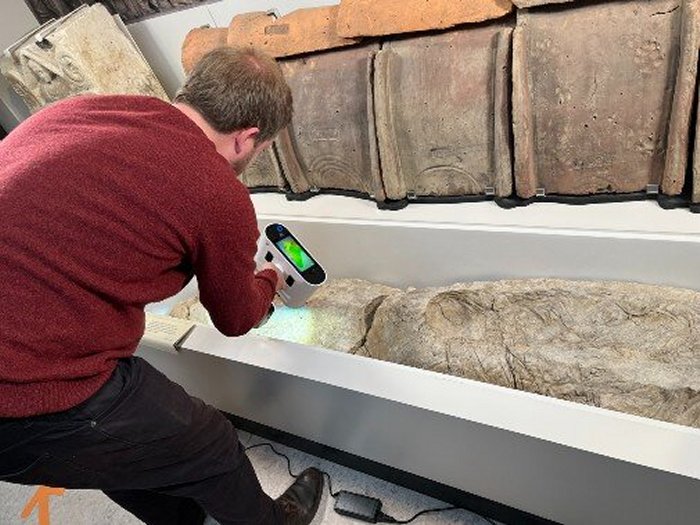Jan Bartek – AncientPages.com – Archaeologists in York have used 3D scans to study the Roman burial practice of pouring liquid gypsum over the bodies of adults and children laid to rest in coffins—the first time this cutting-edge technology has been applied to Roman burials of this type anywhere in the world.
Researchers say the “unparalleled” 3D images have shed new light on this intriguing and unusual burial practice.

A key component of the York project is the 3D scanning of the negative cavities in the gypsum casings. Credit: University of York
For reasons archaeologists do not entirely understand, the Romans sometimes poured liquid gypsum—a mineral used in making various types of cement and plaster—over the clothed bodies of adults and children in lead or stone coffins before burying them.
As the gypsum hardened around the bodies and they then broke down, a negative cavity formed that preserved the original position and contours of the ᴅᴇᴀᴅ. The imprint of shrouds, clothing, and footwear also survives in the gypsum, providing precious evidence for perishable materials that rarely survive in Roman graves.
High status
Researchers say it is not yet clear why and for whom this ritual was chosen, but it appears to have been a custom ᴀssociated with people of high status. Traces of aromatic resins from the Mediterranean and Arabia found earlier in three of the gypsum burials in York indicate the use of costly and exotic substances in the clothing and wrappings, substances available only to the elite.
Roman gypsum burials of varying types have been noted elsewhere in Europe and North Africa, but they are particularly notable in Britain, with a concentration of at least 45 such burials of this type recorded since the late 19th century in and around York.
The Yorkshire Museum has the largest and most important collection of these gypsum burial casts from Britain, and the project is a partnership between the University of York, York Museums Trust, and Heritage360.
Sixteen of these gypsum casings survive and are in the collections of the Yorkshire Museum and were used as part of the York project.
A key component of the York project is the 3D scanning of the negative cavities in the gypsum casings.
Normally, only one individual was buried in a coffin, but for the York Project, researchers chose a gypsum casing of a family of two adults and an infant who died at the same time.
Family tragedy
Professor Maureen Carroll, chair of Roman archaeology at the University of York, said of the gypsum casing of this family, “The 3D images allow us to witness a poignant family tragedy almost 2000 years after it occurred, reminding us not only of the fragility of life in antiquity, but also the care invested in the interment of this group of people.”
Professor Carroll added, “The contours of the three individuals in the gypsum can be seen with the naked eye, but it is difficult to make out the relationship of the bodies to each other and to recognize how they were dressed or wrapped. The resulting 3D model clarifies these ambiguities in stunning fashion.”
The scans reveal that, in preparation for burial and before their disappearance under a layer of liquid gypsum, all of the bodies in the group were completely wrapped from head to toe in shrouds and textiles of varying quality and weave.
Minute details such as the ties used to bind the burial shroud over the head of one of the adults and the bands of cloth used to wrap the infant are clearly visible.
Lucy Creighton, curator of archaeology at the Yorkshire Museum, stated, “These cutting-edge technologies are opening up exciting new ways for the public to experience and connect with our spectacular collections.
“The incredible results of the 3D scan of the family burial group bring us face to face with the past and shows us a moment of tragedy that happened in York more than 1,600 years ago.”
The project team is hoping to secure major research funding to scan all the York gypsum casings. and skeletons to determine their age, Sєx, diet, and geographic origin.
The researchers also hope to better understand the nature and potential social status of textiles used in the burials, and the cultural, ritual, or practical reasons that might have determined this particular method of handling the ᴅᴇᴀᴅ not only in York, but elsewhere in Britain and beyond.
Patrick Gibbs, head of technology, Heritage360, said, “These advanced scanning technologies have been game-changing. Researchers can better analyze archaeological material for details often not visible to the human eye, while the public can explore interactive digital versions of ancient objects in new, more engaging ways. The potential for 3D scanning to offer us a unique window into the past is quickly being realized.”
The research team presented their findings at the York Festival of Ideas on June 3.
Written by Jan Bartek – AncientPages.com Staff Writer





